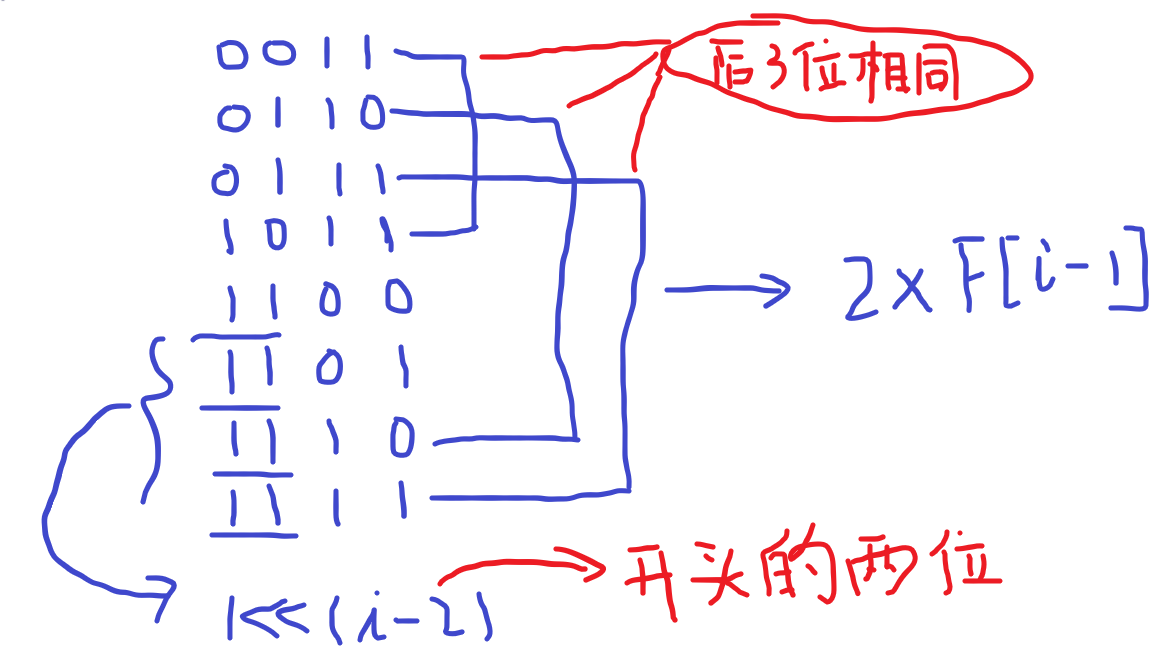A bit is a binary digit, taking a logical value of either 1 or 0 (also referred to as "true" or "false" respectively). And every decimal number has a binary representation which is actually a series of bits. If a bit of a number is 1 and its next bit is also 1 then we can say that the number has a 1 adjacent bit. And you have to find out how many times this scenario occurs for all numbers up to N.
Examples:
Number Binary Adjacent Bits
12 1100 1
15 1111 3
27 11011 2
Input
Input starts with an integer T (≤ 10000), denoting the number of test cases.
Each case contains an integer N (0 ≤ N < 231).
Output
For each test case, print the case number and the summation of all adjacent bits from 0 to N.
Sample Input
7
0
6
15
20
21
22
2147483647
Sample Output
Case 1: 0
Case 2: 2
Case 3: 12
Case 4: 13
Case 5: 13
Case 6: 14
Case 7: 16106127360
详解:http://www.cnblogs.com/jianglangcaijin/archive/2012/10/10/2719029.html
好厉害,能这样找递推公式!!!!!!
F[ i ]表示[ 0,(2^i)-1 ]这个区间上的数字的adjacent bits之和。

1 #include<cstdio> 2 #include<cstring> 3 #include<iostream> 4 #include<algorithm> 5 using namespace std; 6 typedef long long ll; 7 8 int n; 9 ll F[40]; 10 11 void Inite(){ 12 F[1]=0;F[2]=1; 13 for(int i=3;i<=31;i++) F[i]=F[i-1]*2+(1<<(i-2)); 14 } 15 16 ll Solve(int x){ 17 ll ans=0; 18 for(int i=31;i>=0;i--){ 19 if(x&(1<<i)){ 20 x=x-(1<<i); 21 ans=ans+F[i]+max(0,x-(1<<(i-1))+1); 22 } 23 } 24 return ans; 25 } 26 27 int main() 28 { Inite(); 29 30 int kase; 31 cin>>kase; 32 for(int t=1;t<=kase;t++){ 33 cin>>n; 34 printf("Case %d: %lld ",t,Solve(n)); 35 } 36 return 0; 37 }
DP模式:
1 #include<cstdio> 2 #include<cstring> 3 #include<iostream> 4 #include<algorithm> 5 using namespace std; 6 typedef long long ll; 7 8 int n,num[40]; 9 ll dp[40][40][2]; 10 11 ll DFS(int pos,int sum,int pre,bool F){ 12 if(pos==-1) return sum; 13 if(!F&&dp[pos][sum][pre]!=-1) return dp[pos][sum][pre]; 14 15 16 int maxv=F?num[pos]:1; 17 ll ans=0; 18 for(int i=0;i<=maxv;i++){ 19 if(pre&&i) ans=ans+DFS(pos-1,sum+1,i,F&&i==maxv); 20 else ans=ans+DFS(pos-1,sum,i,F&&i==maxv); 21 } 22 23 if(!F) dp[pos][sum][pre]=ans; 24 return ans; 25 } 26 27 ll Solve(int temp){ 28 memset(dp,-1,sizeof(dp)); 29 int cnt=0; 30 while(temp){ 31 num[cnt++]=temp%2; 32 temp/=2; 33 } 34 return DFS(cnt-1,0,0,true); 35 } 36 37 int main() 38 { int kase; 39 cin>>kase; 40 for(int t=1;t<=kase;t++){ cin>>n; printf("Case %d: %lld ",t,Solve(n)); } 41 return 0; 42 }